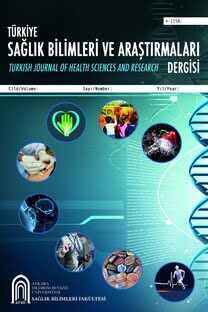COVID-19’un Sesin Akustik ve Fonasyon Özelliklerine Etkisinin İncelenmesi
Amaç: Bu araştırmanın amacı COVID-19’un ses sağlığına etkisini tespit etmek ve sese ait özelliklerin hangi parametrelerini etkilediğini saptamaktır. Yöntem: Bu çalışmaya 18-60 yaş arası toplamda 65 katılımcı dahil edilmiştir. COVID-19 geçirmeyenler, COVID-19 sonrası 3-5 ay geçenler ve COVID-19 sonrası 9 ve daha fazla ay geçenler olmak üzere toplam üç grup vardır. Bu üç grup, sesin akustik ve fonasyon parametreleri açısından karşılaştırılmıştır. Üç grubun değerlendirilmesinde Praat’ın 38 parametresinden sekizi, fonasyon ölçümlerinin ise iki parametresi kıyaslanmıştır. Katılımcıların fonasyon değerlendirmesi için s/z oranları ve maksimum fonasyon süreleri kronometre ile ölçülmüştür. Her bir parametrenin değerlendirilmesi için üçer ölçüm alınmış olup bu üç ölçümün ortalaması kullanılmıştır. Akustik değerlendirme için F0, Jitter %, Shimmer %, Jitter (ppq5), Shimmer (apq11), HNR (Gürültü/Harmonik Oranı), ses kırılma sayısı ve ses kırılma derecesi parametreleri ölçülmüştür. Bulgular: Yapılan analizler, COVID-19’un sesi hem fonasyon özellikleri hem de akustik özellikleri açısından s/z oranı hariç tüm parametrelerde istatistiksel açıdan anlamlı farklılıklar olduğu tespit edilmiştir. s/z oranının anlamlı çıkmaması ise s ve z sürelerinin benzer oranda azalması olarak yorumlanmaktadır. Sonuç: Bu çalışmada, COVID-19’un sesin akustik ve fonasyon parametrelerine etkisi olduğu bulunmuştur. COVID-19’un sese etkisinin daha detaylı analizi için formal değerlendirme araçları ile değerlendirilmelidir.
Investigation Of The Effect Of Covid-19 On The Acoustic And Phonation Features Of Voice
Aim: The aim of this research is to determine the effect of COVID-19 on voice health and to determine which parameters of voice characteristics affect. Method: In this study, 65 participants, aged between 18 and 60, were examined. The participants were categorized into three groups: those without a history of COVID-19, those 3-5 months post-COVID-19, and those 9 or more months post-COVID-19. A comparison was made among these groups based on the acoustic and phonation parameters of their voices. Eight of Praat's 38 parameters and two parameters of phonation measurements were compared in the evaluation of the three groups. For phonation evaluation of the participants, s/z ratios and maximum phonation times were measured with a stopwatch. For each parameter, three measurements were taken and the average of these measurements was utilized. For acoustic evaluation, F0, Jitter %, Shimmer %, Jitter (ppq5), Shimmer (apq11), HNR (Noise/Harmonic Ratio), sound refraction number and sound refraction degree parameters were measured. Results: The analyzes revealed that there were statistically significant differences in all parameters except the s/z ratio in terms of both phonation and acoustic properties of the voice of COVID-19. If the s/z ratio is not significant, it is interpreted as a similar decrease in s and z times. Conclusion: In this study, it was found that COVID-19 had an effect on the acoustic and phonation parameters of the voice. For a more detailed analysis of the voice effect of COVID-19, it should be evaluated with formal assessment tools.
___
- 1. Işık EE. Yüz maskesi takmanın ses algısına etkisi. İstanbul: Üsküdar Üniversitesi; 2021
- 2. Budak F, Korkmaz Ş. Covıd-19 pandemi sürecine yönelik genel bir değerlendirme: türkiye örneği. Sosyal Araştırmalar ve Yönetim Dergisi̇. 2020;62-79.
- 3. Çeti̇n BS. Covid-19 tanısıyla hastanede yatarak tedavi olan hastalarda ses ve yutma bozukluklarının incelenmesi [tez]. İstanbul: Üsküdar Üni̇versi̇tesi̇; 2022.
- 4. Ci̇otti̇ M, Ci̇ccozzi̇ M, Terri̇noni̇ A, Jiang, WC, Wang CB, Bernardini S. The covid-19 pandemic. Cri̇ti̇cal Revi̇ews In Cli̇ni̇cal Laboratory Sci̇ences. 2020;57(6):365-388.
- 5. Casti̇llo AA, Contreras RF, Cantor CLC, Codino J, Guzman M, Malebran C, et al. Voice therapy in the context of the covıd-19 pandemic: guidelines for clinical practice. Journal Of Voi̇ce. 2021;35(5):717-727.
- 6. Shekarai̇ah S, Suresh K. Effect of face mask on voice production during covid-19 pandemic: a systematic review. Journal of Voi̇ce. 2021.
- 7. Gölaç H, Atalık G, Özcebe E, Gündüz B, Karamert R, Kemaloğlu YK. Vocal outcomes after covid-19 infection: acoustic voice analyses, durational measurements, self-reported findings, and auditory-perceptual evaluations. European Archi̇ves of Oto-Rhi̇no-Laryngology. 2022;1-9.
- 8. Asi̇aee M, Vahedi̇an AA, Atashi̇ SS, Keramatfar A, Nourbakhsh M. Voice quality evaluation in patients with covid-19: an acoustic analysis. Journal Of Voi̇ce. 2022;36(6):879-e13.
- 9. Kılıç MA. Ses problemi olan hastanın objektif ve subjektif yöntemlerle değerlendirilmesi. Curr Pracrorl. 2010;6(2):257-265.
- 10. Yeşi̇̇lyurt M. Vokal kord nodülü olan çocuklar ile sağlıklı sese sahip çocukların ses özelliklerinin karşılaştırılması ve vokal kord nodülü olan çocuklarda farklı ses terapisi yöntemlerinin etkililiğinin i̇ncelenmesi. İstanbul: Üsküdar Üni̇versi̇tesi̇; 2020.
- 11. Cavallaro G, Di Ni̇cola V, Quaranta N, Fiorella ML. Acoustic voice analysis in the covid-19 era. Acta Otorhi̇nolaryngologi̇ca Itali̇ca. 2021;41(1):1.
- 12. Rapoport KS, Alnouri̇ G, Sataloff RT, Woo P. Acute vocal fold paresis and paralysis after covid-19 infection: a case series. Annals Of Otology, Rhi̇nology & Laryngology. 2022;131(9):1032-1035.
- 13. Azzam AAA, Samy A, Sefei̇n I, ElRouby I. Vocal disorders in patients with covid 19 in egypt. Indi̇an Journal Of Otolaryngology And Head & Neck Surgery. 2022;74(2):3420-3426.
- 14. Lechi̇en JR, Chi̇esa ECM, Cabaraux P, Mat Q, Huet K, Harmegnies B, et al. Features of mild-to-moderate covid-19 patients with dysphonia. Journal Of Voi̇ce. 2022;36(2):249-255.
- 15. Şen G, Mısırlıoğlu ED. Astımlı çocuklarda COVID-19 etkisi. Türkiye Çocuk Hastalıkları Dergisi. 2021;15(3): 251-255.
- ISSN: 2651-3005
- Başlangıç: 2018
- Yayıncı: Ankara Yıldırım Beyazıt Üniversitesi
Sayıdaki Diğer Makaleler
Elmas AKIN ALTINCI, Esra ÇALIK VAR, Zehra ARIKAN
Kardiyovasküler Hastalıklarda Telerehabilitasyon
Sağlık Kurumlarında Örgütsel Çeviklik: Kavramsal Bir Çerçeve
Tüple Beslenme Desteği Alan Hastalarda Beslenme Bakım Süreci
Boyun Ağrısı Tedavisinde Sanal Gerçeklik Uygulamaları
Burcu Ece KORKMAZ, Yeşim SALIK ŞENGÜL
COVID-19’un Sesin Akustik ve Fonasyon Özelliklerine Etkisinin İncelenmesi
Deniz KAYA SAĞLAM, Maral YEŞİLYURT
Fatma GÜNDOGDU, Nastaran DELJAVAN
Kırşehir İlinde 2015-2020 Yılları Arasında Neonatal Tarama Programı Sonuçlarının İncelenmesi
